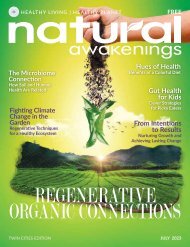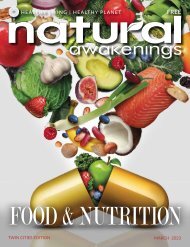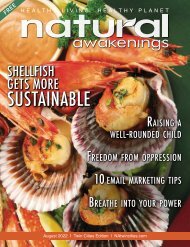Natural Awakenings Twin Cities August 2020
Read the August 2020 edition of Natural Awakenings Twin Cities. This month we focus on Biological Dentistry and Social Justice. Includes articles on no-waste garden edibles, environmental justice issues, interviews with local primary candidates, and more. Natural Awakenings Twin Cities magazine is your source for healthy living, healthy planet information. Have you visited our website lately? Sign up for our Newsletter and Digital Magazine, read archived articles from local experts, and keep up with local healthy living events. Visit NATwinCities.com today.
Read the August 2020 edition of Natural Awakenings Twin Cities. This month we focus on Biological Dentistry and Social Justice. Includes articles on no-waste garden edibles, environmental justice issues, interviews with local primary candidates, and more. Natural Awakenings Twin Cities magazine is your source for healthy living, healthy planet information. Have you visited our website lately? Sign up for our Newsletter and Digital Magazine, read archived articles from local experts, and keep up with local healthy living events. Visit NATwinCities.com today.
You also want an ePaper? Increase the reach of your titles
YUMPU automatically turns print PDFs into web optimized ePapers that Google loves.
Protasov AN/Shutterstock.com<br />
Reevese/Shutterstock.com<br />
Bug Bites<br />
Bumblebees Chew<br />
Leaves to Hasten<br />
Pollen Production<br />
When trying to establish<br />
colonies in early spring,<br />
bees rely on flower<br />
pollen as a protein source for raising their young. Consuelo<br />
De Moraes, a chemical ecologist and entomologist at<br />
Eidgenössische Technische Hochschule Zurich, in Switzerland,<br />
reported in Science that at least three species of<br />
bumblebees use their mouth parts to snip little confetti<br />
bits out of plant foliage, and that the biting gets more<br />
widespread when there’s a pollen shortage. Experiments<br />
show that mustard and tomato plants nibbled by Bombus<br />
terrestris bees bloomed earlier than unbitten plants by<br />
days or weeks. In a caged-bee test, bumblebees trapped<br />
with non-blooming plants were more likely to poke holes<br />
in foliage after three days without pollen than a bee<br />
group buzzing among plentiful flowers. When researchers<br />
switched the bees’ situations, those trapped without<br />
blooms started nibbling leaves, too. Professor of Biology<br />
Dave Goulson, at the University of Sussex, in England, says,<br />
“I can imagine that hungry bees unable to find flowers might<br />
try biting leaves in desperation.”<br />
Hot Topic<br />
Tropical Forests Face<br />
Climate Change Risk<br />
Tropical forests remove and absorb<br />
carbon from the atmosphere<br />
as they grow, and researchers<br />
estimate that despite current<br />
deforestation levels, they still hold<br />
more carbon than civilization has<br />
generated by burning coal, oil and<br />
natural gas over the past 30 years. But as trees stressed by<br />
heat and drought due to global warming die and release<br />
their carbon, their ability to act as reservoirs will diminish.<br />
A global team of more than 200 researchers led by tropical<br />
ecologist Oliver Phillips, of Leeds University, measured<br />
more than half a million trees in 813 forests in 24 countries<br />
to calculate how much carbon the different forests now<br />
store, based on the height, diameter and species of each<br />
tree. Their research, published in Science, also looked at<br />
how carbon storage varied from place to place using data<br />
from 590 long-term monitoring plots. If warming reaches<br />
2° C above preindustrial levels, the study found huge<br />
swaths of the world’s tropical forests will begin to lose<br />
more carbon than they accumulate. Already, the hottest<br />
forests in South America have reached that point.<br />
Gts/Shutterstock.com<br />
Cooling Towers<br />
More Nuclear Reactors on the Way<br />
The U.S. Department of Energy<br />
(DOE) is spending $230 million<br />
this fiscal year to start building<br />
two new prototype nuclear reactors<br />
over the next seven years<br />
as part of an Advanced Reactor<br />
Demonstration Program. Both<br />
will be built in equal partnership<br />
with an industrial firm and could<br />
receive up to $4 billion in funding<br />
from the DOE. Commercial<br />
nuclear generators supply 20<br />
percent of U.S. electrical power<br />
and 50 percent of our carbon-free energy. The inventory<br />
comprises 96 reactors, down from 113 in the early 1990s.<br />
More reactors are slated to close, and the nuclear industry’s<br />
share of the electricity supply is expected to fall, yet<br />
engineers continue to develop designs for reactors they<br />
say will be safer and more efficient. Proponents of nuclear<br />
power doubt the program will spur construction of new<br />
commercial reactors as long as natural gas and renewable<br />
energy remain relatively cheap. Robert Rosner, a physicist<br />
at the University of Chicago, says, “New builds can’t<br />
compete with renewables.”<br />
Caring for your<br />
loved one like<br />
family<br />
Providing assistance with:<br />
personal cares<br />
meal prep and feeding<br />
assistance<br />
medication<br />
administration<br />
transfers and mobility<br />
transportation<br />
advocacy at medical<br />
appointments.<br />
and more!<br />
To learn more, call 763-600-6967<br />
<strong>August</strong> <strong>2020</strong><br />
11

















